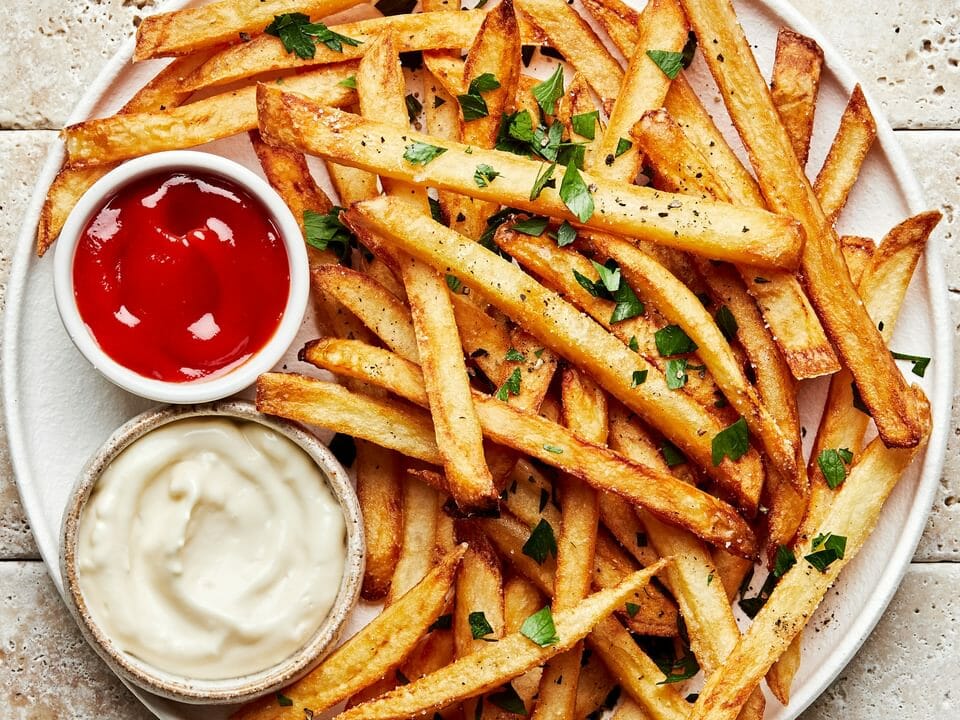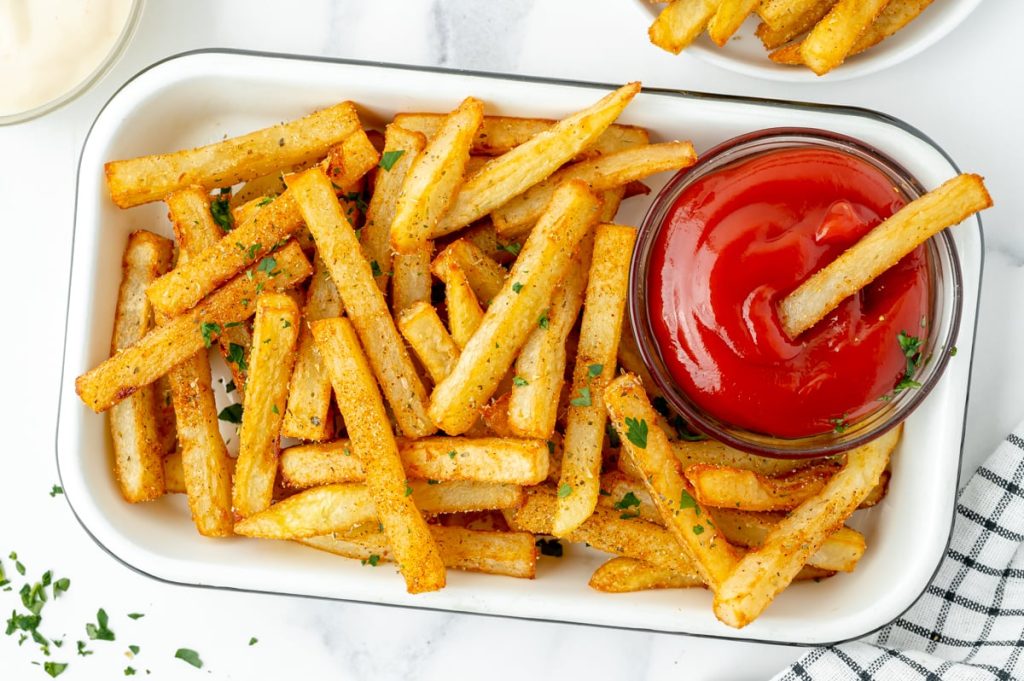Whether served with burgers, dipped in ketchup, or sprinkled with truffle oil, French fries are one of the most beloved foods in the world. Crispy on the outside, soft on the inside, and endlessly customizable fries are more than just a side dish; they’re a cultural icon.
But have you ever wondered where French fries came from? Or how many types exist beyond your local fast food drive-thru? In this article, we’ll take a deep dive into the delicious world of French fries: their origins, variations, cooking methods, and why they continue to capture hearts (and taste buds) worldwide.

What Are French Fries?
French fries are thin strips or wedges of potatoes, typically deep-fried until golden brown and crispy. They’re usually seasoned with salt and served hot. While traditionally made from white potatoes, modern fries can be made from sweet potatoes, yams, or even vegetables like zucchini or carrots.
They’re a global food known as frites in France and Belgium, chips in the UK, and simply fries in the US and many other countries.
The Origins: Are French Fries Really French?
Despite the name, the true origin of French fries is still debated. Many historians believe they actually come from Belgium, where locals were frying fish and potatoes as early as the late 1600s. When rivers froze over in winter, Belgians cut potatoes into fish-like shapes and fried them as a substitute.
The name “French fries” may have emerged during World War I, when American soldiers stationed in Belgium tasted the dish. Since the soldiers were in a French-speaking region, they called them “French fries” and the name stuck.
France, however, also claims to have invented them. Street vendors along the Pont Neuf in Paris were selling fried potatoes in the 18th century, and they remain a staple of French cuisine today.
No matter who invented them, it’s safe to say French fries have become a global phenomenon.
Popular Types of French Fries
Not all fries are created equal. Here are some of the most common and beloved styles:
1. Classic Straight-Cut Fries
The standard fry thin or medium-cut, lightly salted, and deep-fried until golden.
2. Shoestring Fries
Extremely thin and crispy, often served in large portions. Perfect for dipping.
3. Curly Fries
Seasoned and spiral-shaped, with a spiced coating that adds flavor and crunch.
4. Waffle Fries
Criss-crossed in shape and thicker than regular fries. They’re ideal for scooping sauces.
5. Steak Fries
Thick-cut and soft on the inside more like potato wedges. Often oven-baked.
6. Crinkle-Cut Fries
Recognizable by their wavy ridges. They hold onto ketchup and sauces well.
7. Sweet Potato Fries
A slightly healthier, sweeter version of traditional fries. Often served with honey mustard or aioli.
8. Belgian Frites
Thicker and double-fried for maximum crispness. Traditionally served with mayonnaise.
How French Fries Are Made
Making great French fries requires just a few ingredients but timing and technique make all the difference.
Ingredients:
-
Potatoes (Russet is best for frying)
-
Oil (vegetable, canola, or peanut)
-
Salt (or other seasonings)
Basic Steps:
-
Peel and cut the potatoes into your preferred shape.
-
Soak the cut potatoes in cold water for at least 30 minutes. This removes excess starch and makes them crispier.
-
Dry them completely before frying.
-
Fry twice: once at a lower temperature (around 325°F / 160°C) to cook the inside, and then at a higher temperature (375°F / 190°C) to crisp the outside.
-
Drain and season immediately while hot.
Health Considerations
While delicious, traditional French fries are high in calories, fat, and sodium especially when deep-fried in oil and heavily salted. But there are ways to make them healthier:
-
Bake or air-fry instead of deep-frying
-
Use sweet potatoes for added fiber and vitamins
-
Season with herbs and spices instead of salt
-
Dip in yogurt or avocado-based sauces instead of mayo or cheese
Like any indulgent food, moderation is key.
Global Variations of French Fries
French fries have been adopted and adapted in many countries, leading to unique and flavorful variations:
Belgium – Frites with Mayo
Served in paper cones with dozens of sauce options. A national treasure.
United Kingdom – Chips with Vinegar
Thicker-cut fries served with salt and malt vinegar, often alongside battered fish.
Canada – Poutine
Fries topped with cheese curds and smothered in brown gravy. A comforting, messy delight.
Netherlands – Patat Oorlog
“War fries” with mayonnaise, satay sauce, and chopped onions.
Japan – Jaga Bata
Fries served with butter and soy sauce, sometimes topped with seaweed or bonito flakes.
United States – Chili Cheese Fries
A popular fast-food option topped with chili con carne and melted cheese.
South Korea – Honey Butter Fries
A sweet and salty combination made famous by Korean snack trends.
Why People Love French Fries
There are few foods as universally loved as French fries. Here’s why:
Crispy Texture
The crunch of a well-fried French fry is deeply satisfying, especially when paired with a soft, fluffy interior.
Perfect Pairing
Fries go with just about everything burgers, sandwiches, steak, even milkshakes.
Customizable
From shape to seasoning to dips, there are countless ways to enjoy fries. Garlic fries, truffle fries, cheese-loaded fries the options are endless.
Comfort Food
Hot, salty fries are emotionally satisfying. They bring back memories of childhood, diners, road trips, and late-night snacks.
Fun Facts About French Fries
-
McDonald’s is the world’s largest buyer of potatoes, mainly for its French fries.
-
July 13 is celebrated as National French Fry Day in the United States.
-
In 2003, French fries were temporarily renamed “Freedom Fries” in the U.S. due to political tensions with France.
-
The longest fry ever made measured over 34 inches (86 cm) long!
How to Make French Fries Even Better
Want to take your fries to the next level? Try these tips:
-
Use duck fat or beef tallow instead of vegetable oil for richer flavor.
-
Season creatively think paprika, parmesan, rosemary, or Cajun spices.
-
Serve with homemade dipping sauces, like garlic aioli, sriracha mayo, or chipotle ketchup.
-
Toss in herbs or truffle oil immediately after frying for an upscale twist.
Final Thoughts
French fries are far more than a fast-food side dish they’re a culinary canvas. From humble potato slices to gourmet creations, fries have evolved into a global obsession with countless shapes, sauces, and styles.
Whether you like them thin and crispy or thick and fluffy, dipped in ketchup or drenched in gravy, there’s no wrong way to enjoy French fries. So the next time you’re craving comfort food, remember: a great batch of fries is never too far away.

